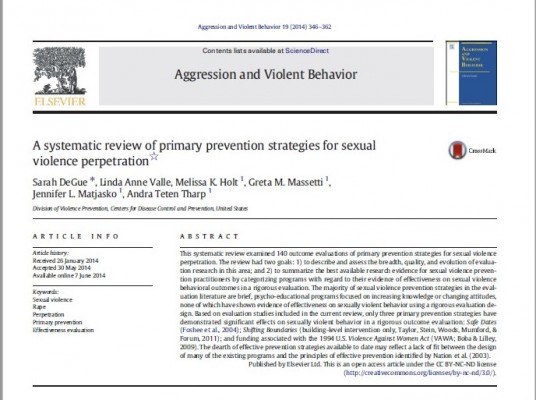Resources Library:
Start a Search:
Systematic Review of Primary Prevention Strategies for Sexual Violence Perpetration

This systematic review from 2014 had two goals related to looking at primary prevention strategies for sexual violence: 1) to describe and assess the breadth, quality, and evolution of evaluation
research in this area; and 2) to summarize the best available research evidence for sexual violence prevention practitioners by categorizing programs with regard to their evidence of effectiveness on sexual violence behavioral outcomes in a rigorous evaluation.
The study found 3 strategies that had significant effects on sexually violent behavior in a rigorous outcome evaluation: Safe Dates (Foshee et al., 2004); Shifting Boundaries (building-level intervention only, Taylor, Stein, Woods, Mumford, & Forum, 2011); and funding associated with the 1994 U.S. Violence Against Women Act (VAWA; Boba & Lilley, 2009).
Tactics of Oppression

Power and control look alike whether perpetrated against an intimate partner or an entire cultural/ethnic group.
Whether we are talking about power and control within an intimate relationship, or within the whole of U.S. society, we see the same tactics used to maintain an unequal distribution of power, control and access to resources.
This handout outlines examples of oppressive tactics used to control individuals in the context of intimate relationships compared with similar tactics used by government entities to control entire ethnic or cultural groups and communities.
Attribution: Content developed by Nathaniel Shara for 2012 Northwest Network Q&A for Advocates Training, Seattle WA - nathan@nwnetwork,org. Used with permission.
Tech Abuse: Information from the Field Survey Findings from the Conference on Crimes Against Women
NNEDV surveyed over 300 conference attendees on what types of technology misuse survivors are reporting, the number of cases their agency sees of technology misuse, and their agency’s ability to respond to survivor’s technology concerns. This report shows their findings.
Tech Talk: Demystifying AI and the Risks it Poses to Survivors of Domestic Violence
The Safety Net team at the National Network to End Domestic Violence (NNEDV) is excited to announce their latest Tech Talk!
In recent years, there have been many advances in artificial intelligence (AI). Highly-capable AI-powered technologies are now easier to access and use by the general audience. In the context of domestic violence, this means a perpetrator has more tools to impersonate and cause harm to a survivor. In this Tech Talk, presenters will clarify some misconceptions surrounding AI and domestic violence, explain the risks AI poses to survivors of domestic violence, and what they can do to mitigate these risks.
This talk is available in English and Spanish.
Click here to access the recordings.
Technology and Abuse in Later Life
Technology is an invaluable resource for older survivors. Individuals may use the Internet, for example, to find support and cope with issues of abuse in later life. Yet, abusers can misuse technology as a tactic of abuse, which can be dangerous and potentially lethal.
In December 2014, with help from Disability Rights Wisconsin, End Domestic Abuse Wisconsin and the Safety Net Project of the National Network to End Domestic Violence, NCALL released this toolkit for older adults with two goals in mind: to provide information about common technologies, including assistive technology, and to identify ways older adults can safeguard themselves from those who misuse technology to control, harass, stalk, and/or threaten them. The toolkit contains the following:
1. Tech 101: Frequently Used Terminology – a glossary of tech terms, many of which are referenced in the toolkit.
2. Tech Tips for Older Adults: Tech Safety – a general overview of computer, cell phone and Internet safety.
3. Tech Tips for Older Adults: Online Privacy & Safety – An overview of the importance of online privacy and strategies for maintaining privacy and safety online.
4. Technology and Abuse in Later Life – An overview of the ways abusers misuse technology within the context of abuse in later life.
5. Assistive Technology – An overview of assistive technology, including what it is, who uses it and resources for finding out more about assistive technology.
6. Examples of Assistive Technology – An overview of assistive technologies for individuals who are Deaf or hard-of-hearing, have speech disabilities, are blind or have low vision, or have physical, motor or communication disabilities.
7. Assistive Technology and Abuse in Later Life – A general overview of the ways abusers may misuse assistive technologies to cause harm.
8. Tech Resources – A list of selected resources related to technology and technology safety.

